Blogging Marvel’s Master of Kung Fu, Part Six
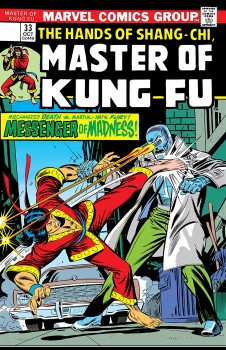 Master of Kung Fu #33 sees writer Doug Moench continuing to build upon the series’ new direction while also continuing to deploy offbeat humor sparingly to great effect. This first installment of a three-part storyline begins when Shang-Chi thwarts an assassination attempt on Clive Reston by a highly-advanced automaton. The reader and Shang-Chi learn from MI5 that the automaton is one of the toys of Mordillo, a robotics genius and master assassin who, it transpires, was the force behind Carlton Velcro.
Master of Kung Fu #33 sees writer Doug Moench continuing to build upon the series’ new direction while also continuing to deploy offbeat humor sparingly to great effect. This first installment of a three-part storyline begins when Shang-Chi thwarts an assassination attempt on Clive Reston by a highly-advanced automaton. The reader and Shang-Chi learn from MI5 that the automaton is one of the toys of Mordillo, a robotics genius and master assassin who, it transpires, was the force behind Carlton Velcro.
Shang-Chi is provided with his own swank London townhouse (courtesy of MI5). While Clive Reston is showing him around his new digs, they encounter Reston’s former lover, seductive MI5 agent Leiko Wu. Her introductory scene, taking a bubble bath and shamelessly dressing (barely) in front of Reston and Shang-Chi establishes her not only as a Bondian seductress, but also signals her as a confident and capable woman who is content to leave a string of broken hearts in her wake. Doug Moench excels at establishing a sense of fatalism in his work. Just as the reader understands that Shang-Chi compromising his principles in working for MI5 will only lead to regret; so too the reader understands that the innocent and somewhat naive Shang-Chi falling for the far more worldly Leiko Wu is also fated to end in pain and suffering. Shang-Chi, in his professional and personal choices, chooses the short-term good and ignores the fact that the long-term can only lead to misery.
The scene shifts to MI5 where Sir Denis leads a meeting focused on Mordillo. We learn of the madman’s penchant for inscribing microscopic messages on the bullets fired by his mechanical assassins. A slide show projection reveals they have retrieved bullets bearing the messages “My Fair Lady,” “Three Blind Mice,” “See How They Run,” and “The Clock Struck One.” Sir Denis then explains that three MI5 agents were recently found dead at the feet of Big Ben with their eyes torn from their sockets. Agent Norris Putnam was also found dead when he turned up at his rendezvous with fellow Agent Simon Bretnor at Tower Bridge. We learn that Simon is Leiko Wu’s current lover. Hearing that Agent Bretnor is missing sends a distraught Leiko Wu running from the room.
MI5 deciphers the final microscopic message as the musical notes to “London Bridge is Falling Down.” Realizing that it is a clue that Mordillo plans a terrorist strike on Tower Bridge, our heroes rush to the scene, hoping to act in time. Arriving at Tower Bridge, they are set upon by the demolition crew, Mordillo’s agents disguised as utility workers. Shang-Chi quickly overcomes them and hurls the explosive into the Thames. Moving to Simon Bretnor’s apartment, they find a letter addressed to Leiko. This slam-bang, action-packed issue ends with the revelation of Leiko in a helicopter held captive by her lover, Simon Bretnor who, of course, is actually Mordillo and is taking her to his exotic island retreat. If there is a flaw in all of this, it is that Moench is easily cramming two issues’ worth of story into a single issue, but the pace is truly breathless. Keith Pollard subbed for Paul Gulacy, but does quite well under the circumstances.
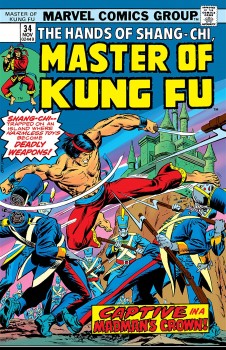 Master of Kung Fu #34 brings us yet another island fortress infiltrated by Clive Reston and Shang-Chi. While Mordillo’s island is significantly different from Carlton Velcro’s, the knowledge that Mordillo financed two such bases is almost comical if one did not recall the international heroin operation which funded them. A brief flashback to a heartbroken Clive Reston seeing Leiko in the arms of their colleague, Simon Bretnor is deeply affecting. In sharp contrast to the Bondian formula of sex without consequences, Moench’s characters are damaged by betrayals. Much closer to John le Carre than Ian Fleming, Moench is interested in exploring betrayals to both lovers and ideologies.
Master of Kung Fu #34 brings us yet another island fortress infiltrated by Clive Reston and Shang-Chi. While Mordillo’s island is significantly different from Carlton Velcro’s, the knowledge that Mordillo financed two such bases is almost comical if one did not recall the international heroin operation which funded them. A brief flashback to a heartbroken Clive Reston seeing Leiko in the arms of their colleague, Simon Bretnor is deeply affecting. In sharp contrast to the Bondian formula of sex without consequences, Moench’s characters are damaged by betrayals. Much closer to John le Carre than Ian Fleming, Moench is interested in exploring betrayals to both lovers and ideologies.
Mordillo’s island is bizarre to say the least with its geodesic dome, Great Pyramid, and life-size recreation of the Old Woman who Lived in a Shoe. Mordillo’s juxtaposition of the childlike with a desire for death and destruction are particularly disturbing. Leiko Wu demonstrates her martial arts abilities when Mordillo/Simon frees her. The conflict may have ended there except for the intervention of Brynocki, Mordillo’s pint-sized cowboy automaton who resembles Clark Gable in the 1961 film, The Misfits. Shang-Chi and Clive Reston ride a life-size talking Little Engine That Could who is determined to drive them over a cliff to their deaths. Meantime, a gloating Mordillo reveals his ultimate weapon to Leiko, the Solar Chute, is technology stolen from MI5 that can weaponize the sun and destroy whole cities, even countries or continents, with concentrated solar rays.
Shang-Chi and Clive Reston battle Mordillo’s army of Marching Wooden Soldiers (from Babes in Toyland) before infiltrating Mordillo’s castle where a Fu Manchu Jack-in-the-Box greets Shang-Chi in a nearly meta example of both Mordillo and Doug Moench’s penchant for the bizarre. The duo are then led by a perpetually smiling mime past a Humpty Dumpty suicide assassin and finally discover Leiko Wu trapped in a giant hour glass which threatens to suffocate her as it fills with sand. Mordillo appears and menaces our heroes with a flame-throwing gauntlet as the second issue comes reeling to its climax.
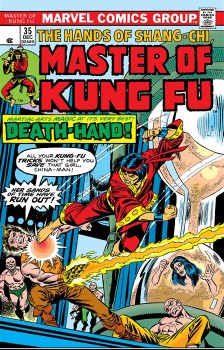 Master of Kung Fu #35 sees Black Jack Tarr come to the rescue in a suit of armor (a nice bit of literalism on Moench’s part). The cowardly Mordillo flees allowing Shang-Chi to rescue Leiko in the nick of time from her hour glass death. Shang-Chi is completely smitten with Leiko, who is doing what is only natural to her in clinging to the next in a long series of lovers. Clive Reston is, understandably, becoming even more embittered. The reader then discovers that Pavane the dominatrix, who was associated with Carlton Velcro, is likewise Mordillo’s mistress in more ways than one. Paul Gulacy loves drawing this character with her dangerous curves and spiteful attitude. The mix of boys’ own adventure, children’s fiction, and the sexually-charged, but ultimately fatal women that appeal to young men driven by their hormones does make for an interesting psychological study of the genre.
Master of Kung Fu #35 sees Black Jack Tarr come to the rescue in a suit of armor (a nice bit of literalism on Moench’s part). The cowardly Mordillo flees allowing Shang-Chi to rescue Leiko in the nick of time from her hour glass death. Shang-Chi is completely smitten with Leiko, who is doing what is only natural to her in clinging to the next in a long series of lovers. Clive Reston is, understandably, becoming even more embittered. The reader then discovers that Pavane the dominatrix, who was associated with Carlton Velcro, is likewise Mordillo’s mistress in more ways than one. Paul Gulacy loves drawing this character with her dangerous curves and spiteful attitude. The mix of boys’ own adventure, children’s fiction, and the sexually-charged, but ultimately fatal women that appeal to young men driven by their hormones does make for an interesting psychological study of the genre.
Mordillo launches the Solar Chute from the geodesic dome with Shang-Chi stowing away on board the launch with the madman. Black Jack Tarr, Clive Reston, and Leiko Wu face off against Pavane until the battling Shang-Chi and Mordillo inadvertently cause the Solar Chute to open fire on Mordillo’s own island retreat. Mordillo, realizing he has been defeated and is facing consequences for his actions, opts to commit suicide by diving into the solar ray that is bombarding the island. Shang-Chi deliberately crashes the launch in the ocean and, once swimming ashore ends up with Leiko Wu in his arms as Clive Reston again embraces pain and bitterness as a second colleague repeats his mistake with the irresistible Leiko Wu. The offbeat final scene has the pint-sized Brynocki cradling his master’s seared skeleton swearing his undying loyalty in promising to never leave his side. There is little doubt that Moench is making a point in having the automaton’s fidelity stand in bitter contrast to the human infidelity the plot has turned upon.
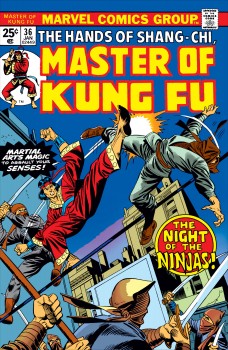 Master of Kung Fu #36 sees Shang-Chi accepting an unlikely offer to act as a bodyguard to the mysterious wizened Moon Sun, a character that appears to be inspired by Master Po from the television series, Kung Fu. The duo are set upon on the streets of New York at night, not by muggers as one might reasonably expect, but Ninjas. Moon Sun is killed with a dagger in the back. Shang-Chi fights the Ninjas off only to discover Moon Sun seemingly resurrected. The old man leads him down into a darkened cellar where Shang-Chi is told to speak his name in the darkness. He is introduced, in turn, to Moon Sun’s caged menagerie comprising a satyr; a werewolf; a fallen angel; a mermaid; a centaur; and a talking two-headed serpent. Moon Sun then returns with Tiko, his beautiful young daughter. Shang-Chi agrees to act as their bodyguard to protect Moon Sun’s Traveling Menagerie of Mysteries. There is no attempt to let the reader into Shang-Chi’s mind in this increasingly offbeat, dreamlike tale. The next day, the unlikely group set off by train to their next destination but are soon set upon by the Ninjas once more as this bizarre issues comes to its cliffhanger conclusion.
Master of Kung Fu #36 sees Shang-Chi accepting an unlikely offer to act as a bodyguard to the mysterious wizened Moon Sun, a character that appears to be inspired by Master Po from the television series, Kung Fu. The duo are set upon on the streets of New York at night, not by muggers as one might reasonably expect, but Ninjas. Moon Sun is killed with a dagger in the back. Shang-Chi fights the Ninjas off only to discover Moon Sun seemingly resurrected. The old man leads him down into a darkened cellar where Shang-Chi is told to speak his name in the darkness. He is introduced, in turn, to Moon Sun’s caged menagerie comprising a satyr; a werewolf; a fallen angel; a mermaid; a centaur; and a talking two-headed serpent. Moon Sun then returns with Tiko, his beautiful young daughter. Shang-Chi agrees to act as their bodyguard to protect Moon Sun’s Traveling Menagerie of Mysteries. There is no attempt to let the reader into Shang-Chi’s mind in this increasingly offbeat, dreamlike tale. The next day, the unlikely group set off by train to their next destination but are soon set upon by the Ninjas once more as this bizarre issues comes to its cliffhanger conclusion.
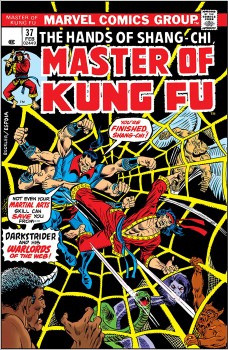 Master of Kung Fu #37 sees Shang-Chi fight off the Ninjas atop the speeding train. Afterwards, he demands to know the truth about the Ninjas and their unseen leader, Dark-Strider who commands the Warlords of the Web, as the Ninjas are known. Each of the mythological creatures comprising Moon Sun’s menagerie relates a completely different account of how Moon Sun came to fall afoul of Dark-Strider in the distant past. A frustrated Shang-Chi asks Tiko who responds, “It is no one’s place to explain the beauty of a mystery.” At this point, it is clear Moench is interested in exploring myths and folklore while hedging closer towards philosophy and metaphysics in a two-part filler story which reflects his personal beliefs and obsessions.
Master of Kung Fu #37 sees Shang-Chi fight off the Ninjas atop the speeding train. Afterwards, he demands to know the truth about the Ninjas and their unseen leader, Dark-Strider who commands the Warlords of the Web, as the Ninjas are known. Each of the mythological creatures comprising Moon Sun’s menagerie relates a completely different account of how Moon Sun came to fall afoul of Dark-Strider in the distant past. A frustrated Shang-Chi asks Tiko who responds, “It is no one’s place to explain the beauty of a mystery.” At this point, it is clear Moench is interested in exploring myths and folklore while hedging closer towards philosophy and metaphysics in a two-part filler story which reflects his personal beliefs and obsessions.
Soon the train reaches its destination and the group work to set up the circus. That night, Shang-Chi discovers Tiko’s secret, a wig and flesh mask conceal the fact that she is horribly disfigured. Saddened, Shang-Chi wanders into the big top to discover Dark-Strider is a hideous man-spider hybrid who has captured each member of the menagerie in his web. After fighting Dark-Strider to a standstill, Shang-Chi comes to realize the menagerie were the Ninjas all along just as Dark-Strider is Moon Sun and both are Death for Death is the Final Mystery. The story ends with a solitary Shang-Chi reflecting that a carnival is a celebration of the farewell to the flesh. This is an interesting if minor storyline which shows the influence of the 1964 film, The Seven Faces of Dr. Lao and is even closer to Charles G. Finney’s original novel, The Circus of Dr. Lao (1935). Doug Moench is one of the great unsung writers of 1970s comics and this series was rapidly on its way to becoming his masterwork.
William Patrick Maynard is a writer and film historian. His commentaries have appeared on releases from MGM, Shout Factory, and Kino-Lorber. He is the authorized continuation writer for the Sax Rohmer Literary Estate and is the author of new Fu Manchu thrillers for Black Coat Press.